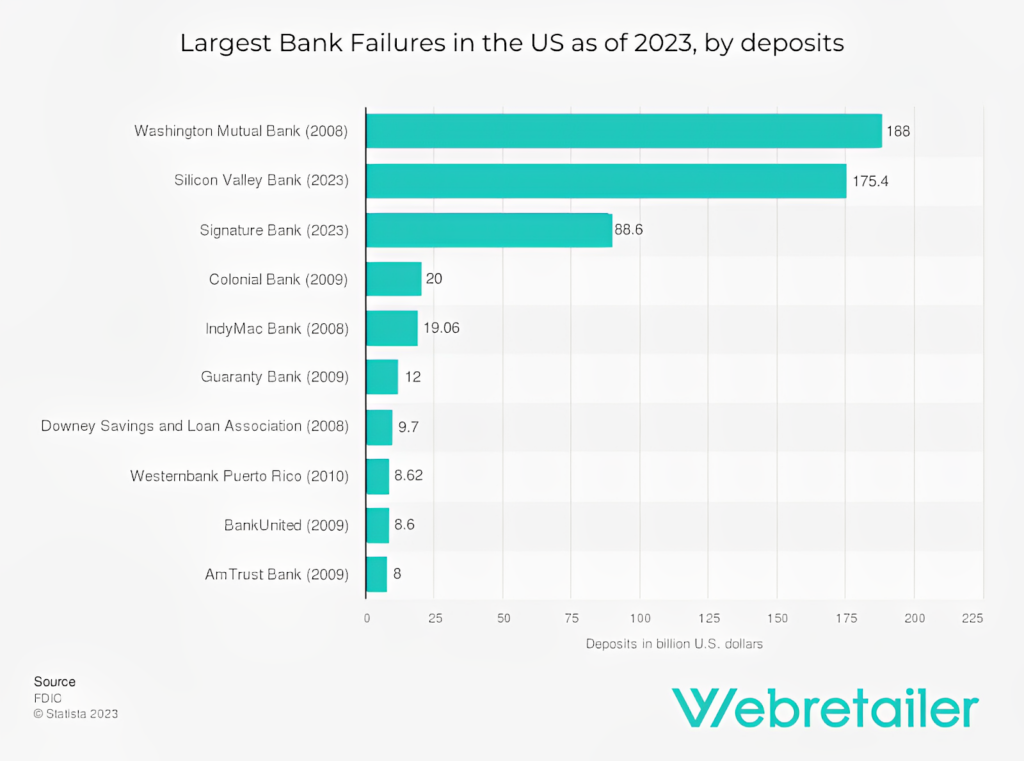The Collapse of Silicon Valley, Djust Launches New Platform and More News
Have you noticed it’s Friday already? It feels like Monday was light years away — so much has happened since then! Last week we had a lot to say about AI and Amazon, but this week a major bank collapse has taken over every news platform. Hopefully, there’ll be some more positive stories coming soon as well. And with that said, let’s get into today’s News Digest.
Today’s news is 1620 words and takes 6 ½ minutes to read.
The Collapse of Silicon Valley Bank: Delayed Etsy Payments Break the Internet
In March 2023, Silicon Valley Bank and Signature Bank experienced bank failures that resulted in the loss of a significant amount of bank deposits. The failures are the second and third largest collapses in the US since 2001.
The collapse is affecting millions of people as we speak (or write), and it remains unknown what will happen with many of the bank’s customers in the foreseeable future.
The only other bigger deposit loss occurred in 2008, when Washington Mutual Bank suffered a loss of 188 billion US dollars. Nonetheless, the sum of SVB and Signature Bank’s lost assets is also exceptionally high, with the overall value approaching the amount lost by all 25 banks that collapsed in 2008.
The graph below depicts the largest bank failures in the United States as of 2023.

Let’s quickly recap what happened to SVB up to today.
Silicon Valley Bank, formerly the 16th-largest bank in the United States, was a financial institution headquartered in Santa Clara, California, with 209 billion US dollars in total assets at the time of its failure (according to the US Federal Deposit Insurance Corporation).
What led to the bank’s downfall?
Two factors contributed to the bank’s troubles: a decrease in venture capital funding in the technology sector and an increase in interest rates.
The bank’s ability to raise new capital dwindled, forcing some clients to use their deposits to fulfill their obligations.
Meanwhile, the bank invested these deposits in bonds that were paying lower returns than bonds issued more recently. When clients began withdrawing their funds, it forced the bank to sell off its bond investments at a loss, rendering it insolvent.
So, what occurred after the bank’s failure? On Friday, the US government seized Silicon Valley Bank’s assets and transferred them to a new entity. This event constituted the second-largest bank failure in US history, following the collapse of Washington Mutual in 2008.
What are some of the biggest companies affected?
The collapse of the Silicon Valley bank affected many companies. They include big names such as Etsy, Roblox, Unity Software, and many others. Analysts predict that if the government doesn’t intervene to rescue the companies impacted by the bank’s downfall, many businesses will have to shut down due to financial losses.
Worried Etsy sellers
The eCommerce world has not been silent about how much money shop sellers can make on the platform. Jewelry, clothing, and digital designers hit the jackpot when their stores became popular on the site. But this week was by far one of the toughest for the art and craft sellers.
How has Etsy addressed the issues?
The collapse of the Silicon Valley Bank is causing Etsy sellers to receive late payments. Etsy has warned its users that they will get their payments later than usual but want to process everything as soon as possible. It remains unclear how many sellers will be waiting for their pay because of the bank’s collapse, but Etsy is ensuring that they’re doing everything they can to get the payments out on time.
An official from Etsy states, “We are working to pay those sellers today and we’ve already started processing payments via another payment partner this morning.”
But shop owners are certainly not calm about not having the ability to pay their bills on time. What’s next? We’ll have to wait and see in the upcoming days or weeks.
Big Retailer News
DJUST Launches New B2B SaaS eCommerce Platform
Djust has recently launched a new platform that will enable B2B buyers and suppliers to transact online. The platform aims to provide a streamlined, efficient, and secure way for businesses to buy and sell goods and services online.
The new solution offers a range of features and tools that will simplify the B2B e-commerce experience. These include customizable storefronts, personalized pricing, and order management tools. The platform also supports a range of payment options, including credit cards, ACH payments, and wire transfers, to provide buyers and suppliers with flexibility and choice.
One of the solution’s key benefits is its ability to integrate with existing enterprise resource planning (ERP) systems and other business software. This allows businesses to seamlessly connect their e-commerce operations with their existing systems, streamlining their processes and reducing the risk of errors.
The launch represents a significant step forward in the B2B e-commerce space.
Are You New to B2B selling?
On that note, are you interested in selling B2B on a platform like Amazon? We’re answering all your questions about B2B eCommerce in this article.
The Future of eCommerce According to Ebay’s Head of AI
What should the eCommerce industry expect from Artificial Intelligence in the upcoming years? Jan Pedersen, the Head of AI at eBay, discusses the future of online commerce with Forbes.
In short, we can expect the future of online commerce to include personalized experiences, automation, and the use of advanced technologies (such as machine learning and natural language processing). Pedersen notes that AI will play a crucial role in enabling retailers to create more personalized shopping experiences by leveraging data to understand customer preferences and behaviors.
The Head of AI at eBay also discusses how automation is transforming the supply chain and logistics processes. He notes that AI optimizes inventory management, improves order fulfillment, and reduces shipping times. This, in turn, enables retailers to offer faster and more reliable delivery services to customers, which is becoming increasingly important in the highly competitive eCommerce landscape.
What does that mean for us?
Well, just as we mentioned last Tuesday — AI is here to stay for the long run. To stay on top of the competition, businesses should at least start to think about implementing various AI solutions. Check out how AI is improving customer service.
Also in the News
- Amazon is making a new web browser. Gizmodo
- Amazon selling NFT’s. The Block
- Walmart, advertising, and inflation. Forbes
International Retailer News
TikTok Considers Separating From ByteDance
TikTok has discussed separating itself from its Chinese parent company, ByteDance, as a last resort to appease US regulators. Pressure has been ramping up on the popular social media app due to national security concerns.
The US government has been scrutinizing TikTok’s ownership by ByteDance, citing potential data privacy and national security risks. In response, ByteDance has tried to distance itself from its Chinese roots by creating a US-based subsidiary and allowing Oracle to become its “trusted technology partner” in the US.
However, US regulators have continued to express concerns over ByteDance’s potential access to TikTok’s user data and have even attempted to force a sale of TikTok’s US operations to American companies.
While discussions of complete separation from ByteDance are reportedly still in the early stages, it highlights the increasing pressure that TikTok is facing from US regulators. We remain to see what actions will TikTok and ByteDance take to address these concerns and protect TikTok’s business operations.
Why is this information important?
Whether you’re a fan of TikTok or think it’s the devil’s work, there’s no denying that it has become a major sales platform for many companies. Without TikTok, many businesses would lose customers, and have difficulty finding new ones. Check out our article on social media marketing and find out why your business should get started on TikTok today.
Amazon in the supply chain
This week we’re also digging into Amazon’s supply chain, examining the company’s approach to logistics and how it has become one of the most successful retailers in the world.
Amazon’s supply chain strategy includes four pillars: fulfillment, delivery, warehousing, and transportation. The first refers to receiving, processing, and preparing orders for shipment. Amazon has invested heavily in its fulfillment centers, equipped with advanced technologies such as robots and automated conveyor systems that help streamline the picking and packing process.
The company has also built a vast network of delivery partners, including third-party logistics providers, shipping carriers, and its fleet of delivery trucks and planes. By having multiple delivery options, Amazon can provide fast and reliable shipping to its customers, regardless of their location.
Amazon operates over 100 million square feet of warehousing space worldwide, focusing on optimizing space utilization and minimizing the distance products need to travel to reach their destination.
Its supply chain strategy is a key driver of its success, enabling it to offer a wide selection of products, fast shipping times, and low prices. By investing in advanced technologies and building a robust logistics infrastructure, Amazon has created an efficient and flexible supply chain. This allowed it to adapt quickly to changing market conditions and customer needs.
What else should you know about Amazon?
Amazon’s supply chain is one thing, but what do you know about its marketing software? Don’t miss out on our list of the best Amazon marketing software solutions!
Also in the News
- Social Commerce. What brands can learn from China. A. List Daily
- Growth of AI in Southeast Asia. KrAsia
- Meta threatens to end news access in Canada. South China Morning Post
Webinars
For everyone
Various dates: Amazon advertising’s global webinar program continues with 20+ webinars scheduled, covering Prime Day Preparation, Sponsored Products, Sponsored Brands, reporting, optimization, and other tips. Amazon.
For US sellers
April 13: Five Consumer Trends All CPG Marketers Need to Know. Tinuiti.
For UK sellers
Various dates: Amazon advertising’s global webinar program continues with 20+ webinars scheduled, covering Prime Day Preparation, Sponsored Products, Sponsored Brands, reporting, optimization, and other tips. Amazon.

Leave a Reply